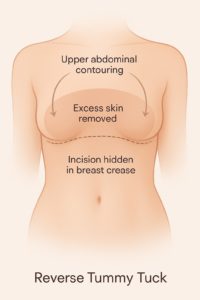When most people think of a tummy tuck, they envision a procedure that tightens the lower abdomen by removing excess skin and tightening the underlying muscles. But what if your concern isn’t below the belly button—but above it?
That’s where the reverse tummy tuck comes in. This lesser-known procedure specifically targets the upper abdominal area, providing a smoother, firmer appearance for patients who struggle with sagging skin or lack of definition above the navel.
Whether due to weight loss, aging, or prior surgery, excess upper abdominal skin can be frustrating—and difficult to treat through diet and exercise alone. A reverse tummy tuck offers a surgical solution tailored to this concern.

What Is a Reverse Tummy Tuck?
A reverse tummy tuck, also known as a reverse abdominoplasty, is a body contouring procedure designed to remove loose or sagging skin above the belly button.
Unlike a traditional tummy tuck—which pulls the skin downward toward the pubic area—a reverse tummy tuck pulls excess skin upward and secures it beneath the breasts or within the inframammary crease. This method helps to tighten the upper abdomen, creating a more toned and lifted midsection.
The procedure does not typically involve the abdominal muscles unless combined with another surgery, making it ideal for patients whose primary concern is loose skin rather than muscle separation.
Reverse Tummy Tuck vs. Traditional Tummy Tuck
While both procedures aim to contour the abdomen, the direction of the lift and the targeted area are what set these surgeries apart.
| Traditional Tummy Tuck | Reverse Tummy Tuck | |
| Target Area | Lower abdomen (below belly button) | Upper abdomen (above belly button) |
| Skin Pull | Downward, toward bikini line | Upward, toward the breast fold |
| Scar Placement | Hidden in the bikini line | Hidden in the natural breast crease |
| Muscle Repair | Often includes abdominal muscle tightening | Rarely includes muscle repair |
| Common Add-ons | Liposuction, lower body lift | Breast lift, liposuction, full tummy tuck |
Some patients may even be candidates for a full abdominoplasty with a reverse tuck for complete abdominal rejuvenation.
When Is a Traditional Tummy Tuck a Better Option?
While a reverse tummy tuck offers excellent contouring for the upper abdomen, it’s not the best solution for everyone. A traditional tummy tuck may be more appropriate if:
- Your main concern is loose skin or stretch marks below the belly button
- You have diastasis recti (separated abdominal muscles) that require tightening
- You’ve had multiple pregnancies or significant weight fluctuations that affected the lower abdomen
- You want more comprehensive abdominal rejuvenation from top to bottom
- You’re not planning to undergo breast surgery and prefer lower scarring
A traditional tummy tuck provides more extensive correction, including muscle repair and skin removal from the lower belly. If both upper and lower laxity are present, your surgeon may recommend a full abdominoplasty or even combining it with a reverse tuck for total refinement.
Who Is a Candidate for a Reverse Tummy Tuck?
You may be a good candidate for a reverse tummy tuck if:
- You have loose or sagging skin above the belly button
- You’ve experienced weight loss or aging that left excess skin on the upper abdomen
- You have good skin elasticity in the lower abdomen but desire contouring above
- You’ve previously had a tummy tuck but still struggle with upper skin laxity
- You’re healthy, close to your goal weight, and have realistic expectations
- You’re not pregnant or planning to become pregnant in the near future
This procedure is particularly effective for post-bariatric surgery patients, or anyone who has lost a significant amount of weight and feels frustrated by loose skin that persists on the upper torso.
Benefits of a Reverse Tummy Tuck
- Improved Upper Abdominal Contour: By removing redundant skin and tightening the upper abdominal area, patients enjoy a smoother, more defined midsection that looks better in fitted clothing and swimwear.
- Hidden Scarring: The incision is placed discreetly along the natural breast crease, making it easily concealed—even in bras or low-cut tops.
- Can Be Combined with Other Surgeries: A reverse tummy tuck is often performed alongside a breast lift, breast augmentation, or liposuction, making it ideal for patients interested in a full upper-body transformation or mommy makeover procedures.
- Permanent Results: As long as your weight remains stable, the results from a reverse tummy tuck are long-lasting. While skin may continue to age naturally, the excess skin removed during surgery will not return.
What Happens During the Procedure?
- Anesthesia: The procedure is typically performed under general anesthesia.
- Incision Placement: Your surgeon will make a horizontal incision hidden beneath the breast fold (inframammary crease).
- Skin Removal: Excess upper abdominal skin is removed, and the remaining tissue is pulled upward for a smoother contour.
- Closure: The incisions are closed with sutures, and drains may be placed temporarily to prevent fluid buildup.
- Recovery Begins: Patients return home the same day with post-operative instructions and a compression garment.
What Is Recovery Like?
Recovery from a reverse tummy tuck is typically mild to moderate, with most patients returning to light activities within 1–2 weeks.
Here’s a general timeline:
- Week 1: You’ll experience some swelling, bruising, and mild discomfort. Rest and limit activity.
- Week 2–3: Sutures and drains (if placed) are removed. Light walking and desk work can resume.
- Week 4–6: You may resume more active movement and begin to notice early results.
- 3–6 Months: Final results begin to show as swelling subsides.
- 1 Year: Scars continue to fade and results stabilize.
Your surgeon will provide personalized aftercare instructions to optimize healing and maintain your results.
Is Liposuction Included in a Reverse Tummy Tuck?
Not by default, but it can be added.
If you have stubborn fat in the upper abdomen or flanks, liposuction can be combined with a reverse tummy tuck to remove fat before tightening the skin. This pairing can enhance your overall result and create a more sculpted look.
Is It Right for You?
If you’ve been frustrated by sagging upper abdominal skin that doesn’t respond to diet, exercise, or even a traditional tummy tuck, a reverse abdominoplasty may be the solution. It’s a highly specialized procedure, and the best way to determine if you’re a candidate is to book a consultation with a board-eligible plastic surgeon who can review your anatomy and aesthetic goals.



Comments are closed here.